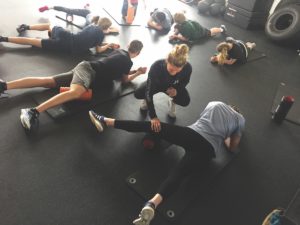Consumer EducationShare With Clients
Tennis: Reduce Pain, Improve Performance
Tennis is one of the most popular sports in the world. In the U.S. alone, there are almost 18 million players, with another 14 million expressing interest (TIA 2018). Unfortunately, the dynamic, forceful twists and turns of the game pose ever-present injury risks to players (Roetert & Kovacs 2011).
If your fitness clientele includes people interested in playing this sport, you need to understand the causes of tennis-related injuries. This will help you develop strategies to improve movement function, reduce pain and keep clients on the court.
Salt Lurks Where You Might Not Expect It
We know foods like deli meats, pizza and potato chips have lots of sodium. But salt also sneaks into less obvious foods, like bread. A 2018 survey by World Action on Salt and Health in London looked at 2,318 bread products from 32 countries (including the United States) and found that more than half of the breads had over 500 milligrams of sodium per 100-gram portion (about 2 slices of packaged bread). Even worse, a third of all breads delivered more than 1,130 mg of salt for every 100 g.
Yes, Unhealthy Eating Is A Killer
We have more proof that diet plays a huge role in staving off some of today’s biggest killers. Nearly half of all U.S. deaths from heart disease, stroke and type 2 diabetes in 2012 could be attributed to substandard eating habits, according to research published in JAMA in 2017. The study was based on death certificate data and funded by the National Institutes of Health and the National Heart, Lung, and Blood Institute.
Sports Teams Go To Bat For Junk Food
Here is just one more reason why playing a sport is healthier than sitting on the couch watching a game. Researchers from NYU School of Medicine analyzed advertisements associated with the 10 professional sports organizations most popular among fans aged 2–17. Focusing on ads on TV, YouTube and team websites, the scientists set out to determine whether marketing was influencing the consumption of certain foods and nonalcoholic beverages.
To Grow Healthier, Happier Adults, Raise Fit Kids
Today’s inactive kids are tomorrow’s unhealthy adults. Our society will pay the price for young people’s profound lack of exercise if we fail to turn this trend around. Few behaviors more significantly influence child health than physical activity. Yet children and adolescents are not moving enough, at the expense of their own health as well as that of their communities. More needs to be done to support families and society in raising fit kids.
Ask the RD
Question: I have heard that drinking apple cider vinegar is good for weight loss. Is that true, or is it too good to be true?
Answer: Apple cider vinegar has a cure-all reputation for helping with weight loss, cholesterol,
diabetes, acne, digestive problems and other issues. The truth is somewhat less impressive, but apple
cider vinegar does have proven health benefits.
Caffeine Boosts Performance in Athletes Who Use It Rarely
Caffeine stimulates the central nervous system, allowing athletes of all stripes to complete longer, harder workouts. But new research suggests that people who usually avoid coffee and energy drinks likely benefit the most from caffeine.
Why We Eat Too Much at Night
It’s 10 p.m., you’re catching up on email, and it suddenly hits you: a Goliath-sized craving for chocolate-chunk ice cream. Findings in the International Journal of Obesity show why the evening hours pose such a high risk for overeating and unhealthy munching. For the study, researchers from Johns Hopkins University School of Medicine recruited 32 adults with excess weight who volunteered for two experimental protocols:
More Sugar, Less Nutrition
Eating too much sugar is not only bad news for our waistlines; it can also make our diets less potent. Dietary survey data from 6,150 adults in an American Journal of Clinical Nutrition (AJCN) study revealed that high intakes of “free sugar” (sugar added to packaged foods like yogurt and cereal or to home-cooked foods) can coincide with lower consumption of several important micronutrients, including calcium and magnesium.
The Long-Term Benefits of Pedometer Use
Studies show that tracking daily steps with a pedometer leads to higher activity levels. A new report out of the U.K. suggests the practice can inspire people to take more steps for many years.
The report included data from two separate 12-month studies; one involved inactive adults aged 45–75, while the other featured older adults aged 60–75. In the first, participants were assigned to one of three 12-week pedometer-based interventions—consultation with a nurse, support by mail or no consultation. In the second, there was no mail support group.
Research Review: Pros and Cons of Standing
Sitting for extended periods of time is now considered as dangerous as smoking cigarettes, and as a result, many people have taken to standing during the workday. New research is shedding light on both positive and negative effects of the current trend.
Stand Up for Weight Loss
Body Fat Is Better Indicator of Type 2 Diabetes
Here’s more reason to apply a battery of assessments when determining a client’s health status. Scientists have found that body fat percentage is a more accurate indicator of a person’s risk for prediabetes or type 2 diabetes than other popular measures like body mass index.
Are You as Active as You Think You Are?
When it comes to physical activity levels, our self-perceptions shouldn’t always be trusted, say researchers across the U.S. and Europe.
Research Update: The Value of Exercise for Women’s Health
Fitness pros have a unique opportunity to take a leadership role by guiding their female clients toward a healthier, movement-oriented lifestyle. This women’s health research update discusses contemporary scientific findings you can use to educate your clients and plan up-to-date programs.
Why Water Fitness?
While water fitness was once the domain of older adults, now participants of all ages and ability levels are benefiting from aquatic workouts. Shirley Archer, JD, MA, water fitness specialist and health and wellness blogger, examines what’s new in aquatic training research and looks at different types of programs.
Research Update
Here are some of the newer findings related to aquatic training:
A for Effort
client: Kent Denver School Students | personal trainer: Laura Bordeaux, strength and conditioning coach, Kent Denver School location: Englewood, Colorado
A complete course load. Think of it as core curriculum—literally. The Kent Denver School, a college-preparatory institution outside of Denver, offers a comprehensive educational experience that emphasizes both academics and sports. That’s where Laura Bordeaux comes in.
Stand Up to Aging
Getting up off the ground grows more difficult as we age. Muscles and bones weaken, coordination becomes less fluid, and simply doing chores around the house gets more challenging. Ground-to-standing (G2S) exercises address these changes. hile even performance athletes can benefit from G2S drills (see the sidebar “G2S Exercises Also Help Performance Athletes”), they’re supremely helpful for older exercisers who are at risk for broken hips and other threats to their mobility.
The Pancreas: Two Glands in One
Located behind the stomach in the upper abdomen, the pancreas is a glandular organ that has two primary “jobs.” It is both a digestive exocrine gland (secreting products via ducts) and a hormone-producing endocrine gland (secreting substances directly into the bloodstream). The pancreas excretes enzymes to break down the foods we eat, and it secretes insulin and glucagon to control blood sugar (Taylor 2018). Spongy, and shaped like a flat pear, it’s about 6–10 inches long (Columbia University Medical Center 2018).
High-Intensity Interval Training for Fat Loss
Two recent studies reveal that high-intensity interval training has the ability to produce high-impact fitness gains in a short time frame.
Physical Activity Can Reduce Burnout
Burnout is an issue in the modern world, with annual costs to society estimated at more than $136 billion. Physical activity can reduce the risk of burnout, defined as a severe and persistent form of fatigue that occurs after a long period of work stress.
Options that reduce professional burnout are good news for employers. Fitness pros who want to promote corporate wellness can share the following study with business owners to highlight the benefits of onsite fitness programs.



















